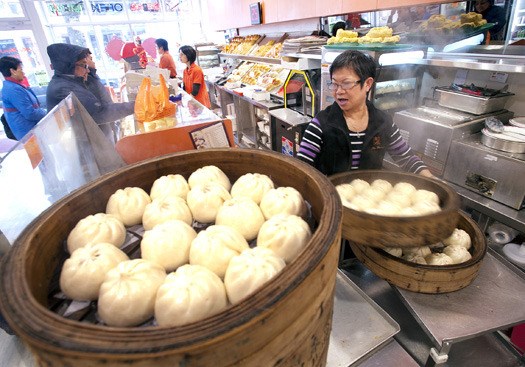When I first moved to Strathcona, Chinatowns next-door neighbourhood, almost three years ago, one could hardly buy a piece of pizza inside the historic red gate after dusk. Chinatown once a hotbed of neon signs, nightlife and cabarets, along with a bustling shopping and business district had spent a number of years in decline. Close proximity to the Downtown Eastside and a dwindling population (many residents migrated to other less expensive parts of the city) meant that the neighbourhood essentially went dark once the business day ended.
But those days appear to be coming to an end. Its become clear that Canadas oldest Chinatown is in the midst of a calculated transformation. Sure, the scores of fragrant dry good stores, daytime markets and teashops, traditional (and not-so-traditional) clothing stores and only-in-Chinatown accessory and interior shops are still there. There are still plenty of options for dim sum, steamed buns and Vietnamese subs. The Chinatown summer night market is still awash with sweet-smelling foods on sticks and knick-knacks you might regret in the morning, and the annual Chinese New Year celebrations fill the streets.
But peppered amongst the traditional culture is a swath of new businesses artist-run centres, nightclubs and pubs, smartly designed restaurants, carefully curated clothing shops. These new entrepreneurs tend to cater to the influx of new condo residents who inhabit southern Chinatown near Main and Union and attract a younger, hipper clientele from across the city.
But can these two worlds coexist?
Chinatown is a historic gem, says senior city planner Kevin McNaney. Maintaining the heritage of Chinatown while still encouraging new, diverse businesses and residents is at the heart of the citys Chinatown Revitalization Plan. Its about bringing in the new without displacing the old. Chinatown is a very resilient community; its always been in transition.
The city is navigating this transition in a number of ways nurturing its traditional aesthetic by investing in neon signs, providing façade and storefront grants to restore heritage buildings, and promoting it as a must-see tourist destination. (It was named a national historic site in October of last year). The city has also been planting the seed for new residents and businesses by allowing taller building heights in some areas. The idea, says McNaney, is to bring more body heat to the neighbourhood and make it more of a 24-7 community.
One of the neighbourhoods oldest shops, New Town Bakery, has just revealed its shiny, new location on Pender, just two doors down from the space it occupied for over 30 years. The owner, Susanna Ng, started working in the neighbourhood when she was 17. For her, Chinatown has changed a lot. It used to be much busier, with people doing all of their grocery shopping here and taking their kids to the English language schools she says. Although the Chinatown location is not as profitable as it once was (her locations in Burnaby and Surrey supplement this one), it is important for her to maintain a presence in the neighbourhood not only for tourists, but for her regular customers.
Ng welcomes the new people discovering the neighbourhood, but worries about the authenticity of Chinatown for the second generation without new immigrants and people to take over the traditional Chinese stores when she and her peers retire, they might eventually disappear.
Her 28-year-old son, Ken, echoes her concerns. I think the problem with the Chinese arches is that there are fewer and fewer Chinese businesses, and over time thats going to be the trend. You have higher rent and prices, but all authentic Chinese stuff is cheap. People cant continue to run their businesses in that kind of market, he says.
On the southern end of Chinatown, near the Jimi Hendrix shrine, the new generation is setting up shop. This Space, soon to be renamed Harvest, is a 600 sq.ft., non-descript storefront on Union set to open as a local, organic food store with later hours in March. Owner Michael Leung, 38, and his business partner Joshua Michnik, 28, took the unique step of employing crowd-sourcing techniques to determine what kind of business the community wanted most. By voting online or paying a visit to the store, the neighbourhood decided what type of business it should be, what it would be named, who would design it, and eventually will even help decide what types of products are carried.
Leung used to drive his late mother to Chinatown from her house on Victoria Drive to visit the two main grocery stores on Georgia and Gore. He moved back to the city early last year, after years of working in the non-profit sector abroad, and saw the opportunity to invest in a community in flux.
Chinatown as a hub has kind of shrunk, says Leung. Chinese grocery shopping has evolved to South Victoria and many of the people from 10, 15 years ago dont want to come down here and deal with parking and all of that. So for us, its all about the local residents.
Their project has been about having a dialogue with those local residents both positive and negative. Michnik says at first, people were skeptical and thought they were a development company trying to pull a fast one. But thats changed as the community has gotten to know them.
Talking to the neighbours over the past six months has also opened his eyes to the complexities of the area. I didnt know the dynamics of this neighbourhood before I started talking to people like people getting confined to a smaller and smaller area because of gentrification, says Leung. If this becomes a better place to live, with less crime, then obviously rent is going to go up and people arent going to be able to afford to live here. But will our business be inviting enough and continue to include our neighbours? I hope so.



